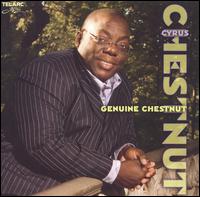 The pianist Cyrus Chestnut is one of jazz's most convincing anachronisms. His brand of crisp articulation and blues-inflected harmony evokes another era, sometime before the ascent of Bill Evans and McCoy Tyner, to say nothing of Herbie Hancock and Keith Jarrett. But unlike the typical nostalgist, who pines for the past partly because of a queasy discomfort with the present, Mr. Chestnut appears comfortable with his placement in time.
The pianist Cyrus Chestnut is one of jazz's most convincing anachronisms. His brand of crisp articulation and blues-inflected harmony evokes another era, sometime before the ascent of Bill Evans and McCoy Tyner, to say nothing of Herbie Hancock and Keith Jarrett. But unlike the typical nostalgist, who pines for the past partly because of a queasy discomfort with the present, Mr. Chestnut appears comfortable with his placement in time. What makes his music fly is a complete security in his style, and that sense of untroubled self-assurance was one of the best things about Mr. Chestnut's first set at the Jazz Standard on Thursday night. Working with his regular rhythm partners, Michael Hawkins on bass, and Neal Smith on drums, Mr. Chestnut played music tinged by gospel coloration and rooted in earthy swing.
He started with a familiar ballad, "East of the Sun (and West of the Moon)," which he had rearranged at a medium tempo. His initial variations on the theme, over a springy two-step feel, were carefully constrained. But as the rhythm section shifted into 4/4 walking swing, he tossed off a succession of major-key tremolos, block chords and bluesy trills. It added up to a sound evocative of the classic Wynton Kelly Trio.
The bulk of the ensuing set featured material from "Genuine Chestnut" (Telarc), Mr. Chestnut's likable recent album. He dusted off the Dave Bartholomew-Fats Domino shuffle "I'm Walkin,' " employing a riff-based approach that extended well into his solo. His playing was more multifaceted and dynamic on a pair of originals, the soul-jazz cooker "Mason-Dixon Line" and the rhythm-and-blues-tinged "Baby Girl's Strut."
Mr. Smith and Mr. Hawkins capably carried both of those themes, making the most of a bar of 5/4 nestled in the form of "Baby Girl's Strut." Mr. Smith also soloed, with brushes, on "Mason-Dixon Line," adding little excitement but faithfully adhering to the theme.
But Mr. Chestnut was the evening's star and he brought charisma to the role, at least in a musical sense. (His spoken interludes, though charmingly self-deprecating, tended not to get the response he was looking for.) He played with subtlety, intimacy and clarity on a gospel ballad that sounded something like "Lord, I Give Myself to You," the spiritual that closes the album.
The song that closed the set was a spiritual only in a looser sense: it was "Body and Soul," a staple of jazz performance since the 1930's. Mr. Chestnut could easily have plumbed its depths and come up with a moving ballad interpretation.
Instead he chose to showcase what he called "the slow-jam version" of the song, simplifying its harmonic contours and setting up a light-soul groove. It was a letdown, not because so-called contemporary jazz is beneath Mr. Chestnut, but because he works so much better in another mode.
By NATE CHINEN - nytimes.com
No comments:
Post a Comment